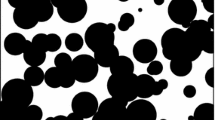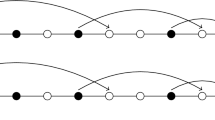Abstract
We consider the simple linear Boolean model, a fundamental coverage process also known as the Markov/General/∞ queue. In the model, line segments of independent and identically distributed length are located at the points of a Poisson process. The segments may overlap, resulting in a pattern of “clumps”–regions of the line that are covered by one or more segments–alternating with uncovered regions or “spacings”. Study and application of the model have been impeded by the difficulty of obtaining the distribution of clump length. We present explicit expressions for the clump length distribution and density functions. The expressions take the form of integral equations, and we develop a method of successive approximation to solve them numerically. Use of the fast Fourier transform greatly enhances the computational efficiency of the method. We further present inference procedures for the model using maximum likelihood techniques. Applications in engineering and biomedicine illustrate the methods.
Similar content being viewed by others
References
R. Arratia, E. S. Lander, S. Tavare, and M. S. Waterman, “Genomic mapping by anchoring random clones: A mathematical analysis,” Genomics vol. 11 pp. 806–827, 1991.
N. H. Bingham, and S. M. Pitts, “Non-parametric estimation for the M/G/∞ queue,” Annals of the Institute of Statistical Mathematics vol. 51 pp. 71–97, 1999.
E. O. Brigham, The Fast Fourier Transform and its Applications, Prentice Hall: Upper Saddle River, New Jersey, 1988.
C. M. Crespi, W. G. Cumberland, and S. Blower, “A queueing model for chronic recurrent conditions under panel observation,” Biometrics vol. 61 pp. 194–199, 2005.
D. J. Daley, “The busy periods of the M/GI /∞ queue,” Queueing Systems vol. 38 pp. 195–204, 2001.
T. Grift, “Fundamental mass flow measurement of solid particles,” Particulate Science and Technology vol. 21 pp. 177–193, 2003.
T. Grift, J. T. Walker, and J. W. Hofstee, “Mass flow measurement of granular materials in aerial application –Part 2: Experimental model validation,” Transactions of the ASAE vol. 44 pp. 27–34, 2001.
P. Hall, Introduction to the Theory of Coverage Processes, Wiley: New York, 1988.
J. C. Handley, “Discrete approximation of the linear Boolean model of heterogeneous materials,” Physical Review E vol. 60 pp. 6150–52, 1999.
J. C. Handley, “Computationally efficient approximate likelihood procedures for the Boolean model,” Computational Statistics and Data Analysis vol. 45 pp. 125–136, 2004.
J. C. Handley, and E. R. Dougherty, “Optimal nonlinear filter for signal-union-noise and runlength analysis in the directional one-dimensional discrete Boolean random set model,” Signal Processing vol. 51 pp. 147–166, 1996.
L. Kleinrock, Queueing Systems Volume I: Theory, Wiley: New York, 1975.
K. Lange, Numerical Analysis for Statisticians, Springer: Berlin Heidelberg New York, 1999.
I. Molchanov, Statistics of the Boolean Model for Practitioners and Mathematicians, Wiley: Chichester, England, 1997.
P. R. Parthasarathy, “The effect of superinfection on the distribution of the infectious period–a continued fraction approximation,” IMA Journal of Mathematics Applied in Medicine and Biology vol. 14 pp. 113–123, 1997.
J. K. Percus, Mathematics of Genome Analysis, Cambridge University Press: Massachusetts, 2002.
L. Perko, Differential Equations and Dynamical Systems, Springer: Berlin Heidelberg New York, 1991.
W. Rudin, Principles of Mathematical Analysis, 2nd ed., McGraw-Hill: New York, 1964.
W. Stadje, “The busy period of the queueing system M/G/∞,” Journal of Applied Probability vol. 22 pp. 697–704, 1985.
L. Takacs, Introduction to the Theory of Queues, Oxford University Press: New York, 1962.
A. Wald, L. Corey, R. Cone, A. Hobson, G. Davis, and J. Zeh, “Frequent genital herpes virus 2 shedding in immunocompetent women: Effect of acyclovir treatment,” Journal of Clinical Investigation vol. 99 pp. 1092–97, 1997.
K. Yosida, Lectures on Differential and Integral Equations, Interscience: New York, 1960.
Author information
Authors and Affiliations
Corresponding author
Rights and permissions
About this article
Cite this article
Crespi, C.M., Lange, K. Estimation for the Simple Linear Boolean Model. Methodol Comput Appl Probab 8, 559–571 (2006). https://doi.org/10.1007/s11009-006-0429-6
Received:
Revised:
Accepted:
Published:
Issue Date:
DOI: https://doi.org/10.1007/s11009-006-0429-6




